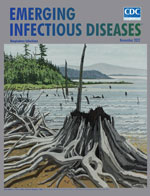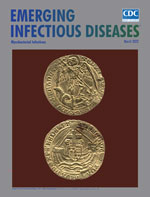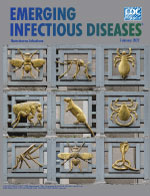Etymologia
Etymology is concerned with the origin of words, how they've evolved over time, and changed in form and meaning as they were translated from one language to another. Below is a listing of etymology topics covered in the Emerging Infectious Diseases journal.
Volume 28—2022
Volume 28, Number 11—November 2022

Etymologia: Pseudoterranova decipiens
| EID | Partin WC, Bradbury RS. Etymologia: Pseudoterranova decipiens. Emerg Infect Dis. 2022;28(11):2302-2303. https://doi.org/10.3201/eid2811.220792 |
|---|---|
| AMA | Partin WC, Bradbury RS. Etymologia: Pseudoterranova decipiens. Emerging Infectious Diseases. 2022;28(11):2302-2303. doi:10.3201/eid2811.220792. |
| APA | Partin, W. C., & Bradbury, R. S. (2022). Etymologia: Pseudoterranova decipiens. Emerging Infectious Diseases, 28(11), 2302-2303. https://doi.org/10.3201/eid2811.220792. |
Volume 28, Number 8—August 2022

Dermatophilus congolensis
| EID | Ollhoff RD, Pogliani FC, Sellera FP. Dermatophilus congolensis. Emerg Infect Dis. 2022;28(8):1663. https://doi.org/10.3201/eid2808.212573 |
|---|---|
| AMA | Ollhoff RD, Pogliani FC, Sellera FP. Dermatophilus congolensis. Emerging Infectious Diseases. 2022;28(8):1663. doi:10.3201/eid2808.212573. |
| APA | Ollhoff, R. D., Pogliani, F. C., & Sellera, F. P. (2022). Dermatophilus congolensis. Emerging Infectious Diseases, 28(8), 1663. https://doi.org/10.3201/eid2808.212573. |
Etymologia: Anopheles culicifacies
| EID | Kumar G. Etymologia: Anopheles culicifacies. Emerg Infect Dis. 2022;28(8):1728. https://doi.org/10.3201/eid2808.211875 |
|---|---|
| AMA | Kumar G. Etymologia: Anopheles culicifacies. Emerging Infectious Diseases. 2022;28(8):1728. doi:10.3201/eid2808.211875. |
| APA | Kumar, G. (2022). Etymologia: Anopheles culicifacies. Emerging Infectious Diseases, 28(8), 1728. https://doi.org/10.3201/eid2808.211875. |
Volume 28, Number 3—March 2022

Schizophyllum commune
| EID | Mahajan M. Schizophyllum commune. Emerg Infect Dis. 2022;28(3):725. https://doi.org/10.3201/eid2803.211051 |
|---|---|
| AMA | Mahajan M. Schizophyllum commune. Emerging Infectious Diseases. 2022;28(3):725. doi:10.3201/eid2803.211051. |
| APA | Mahajan, M. (2022). Schizophyllum commune. Emerging Infectious Diseases, 28(3), 725. https://doi.org/10.3201/eid2803.211051. |
Volume 28, Number 2—February 2022

The Color Puce (Pyüs)
| EID | Partin C. The Color Puce (Pyüs). Emerg Infect Dis. 2022;28(2):302. https://doi.org/10.3201/eid2802.212274 |
|---|---|
| AMA | Partin C. The Color Puce (Pyüs). Emerging Infectious Diseases. 2022;28(2):302. doi:10.3201/eid2802.212274. |
| APA | Partin, C. (2022). The Color Puce (Pyüs). Emerging Infectious Diseases, 28(2), 302. https://doi.org/10.3201/eid2802.212274. |
Page created: January 04, 2022
Page updated: October 24, 2022
The conclusions, findings, and opinions expressed by authors contributing to this journal do not necessarily reflect the official position of the U.S. Department of Health and Human Services, the Public Health Service, the Centers for Disease Control and Prevention, or the authors' affiliated institutions. Use of trade names is for identification only and does not imply endorsement by any of the groups named above.




